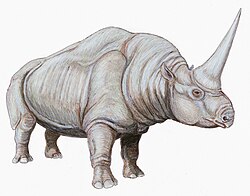Relationships
The exact placement of Nanotitanops within Brontotheridae is uncertain. There are other small brontotheres from the Eocene of Asia such as Microtitan , Pygmaetitan , and Protitan though morphological evidence does not support a monophyletic relationship between them. Morphological analysis tends to put Nanotitanops in a polytomy near the node of the subfamily Brontotheriinae. [4] [5] It has been proposed as a possible sister taxon to Epimanteoceras formosa. [3] Nanotitanops was originally named Nanotitan , but this genus name was preoccupied by an orthopteroid insects from the Triassic of Kyrgyzstan. [2] The genus name is derived from the Greek nanos, meaning dwarf, titan, referring to the Titans of Greek mythology, and the Greek suffix -ops, meaning face. The specific epithet of the only species refers to the village in which the first and only specimens have been found. [1]
This page is based on this
Wikipedia article Text is available under the
CC BY-SA 4.0 license; additional terms may apply.
Images, videos and audio are available under their respective licenses.









